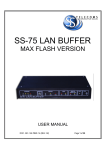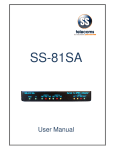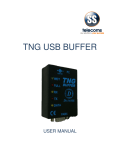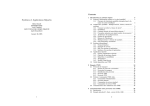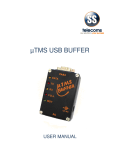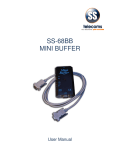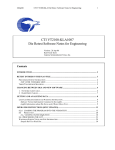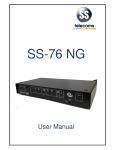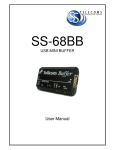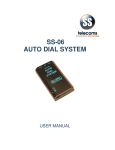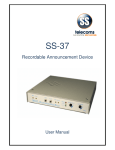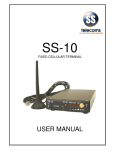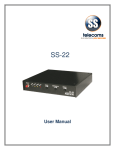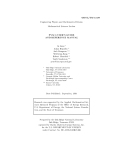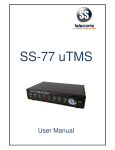Download SS-76 MF GPRS Buffer
Transcript
SS-76 MF GPRS Buffer User Manual SS-76 MF GPRS USER MANUAL History of changes Revision 01 Revision 02 Revision 03 Revision 04 Revision 05 Revision 06 Revision 07 Original document Added section on Getting IMEI numbers etc. Correct name (SS-76) S/W update with new (IMEI and SCID) commands Draft for market release Cosmetic changes Add Alternate ETX character 01 October 2006 13 October 2006 14 November 2006 26 November 2006 18 January 2007 20 March 2008 23 February 2010 CONTENTS 1. INTRODUCTION ............................................................................................... 3 2. FEATURES ....................................................................................................... 3 3. 3.1 3.2 3.3 BASIC SETUP ................................................................................................... 4 SIM CARD ......................................................................................................... 4 GPRS SETUP ................................................................................................... 4 BUFFER SETUP ............................................................................................... 4 4. GPRS MODULE COMMANDS .......................................................................... 5 5. BUFFER SETUP ............................................................................................... 6 6. BUFFER COMMANDS ...................................................................................... 6 7. CALL LOGGING & DIAGNOSTIC COMMANDS ................................................ 7 8. CONTACT DETAILS ......................................................................................... 8 DOC. NO.: SS-76MF GPRS-14 (ISSUE 07) Page 2 of 8 SS-76 MF GPRS USER MANUAL 1. INTRODUCTION The purpose of the SS-76 is to provide a buffer where the buffer collects data via its serial interface and sends the data out to a centralised site, using UDP Logger, via the GPRS network. 2. FEATURES Utilizes any currently available size Compact Flash memory Battery backup Remote setup Built in power supply LED indicators for GPRS NET – indicates that the unit is logged on to the GPRS network SVR – indicates that contact has been established with the server TX – indicates that data is being sent to the GSM module RX – indicates that data is being received from the GSM module BUFFER Heartbeat – indicates that the unit is functional 50% - indicates when 50% of the buffer’s memory capacity is reached 80% - indicates when 80% of the buffer’s memory capacity is reached PABX TX – indicates that the buffer is transmitting data to the PABX RX – indicates that the buffer is receiving data from the PABX REMOTE DOWNLOAD TX – indicates that the buffer is transmitting data to the GPRS module RX – indicates that the buffer is receiving data from the GPRS module 1 PWR – indicates that there is power being supplied to the unit Diagnostics • PING – to test internet availability • DNS lookup – to find the logging server’s IP address by using its DNS-name SNTP (Simple Network Time Protocol) support – the unit date and time stamps the records using date and time information received from an internet time server. Push operation allows use of INTERNET APN Please Note the following: 1. The REMOTE DOWN LOAD TX & RX and GPRS TX & RX will frequently flash simultaneously 2. For a list of abbreviations please consult our website at www.sstelecoms.com 3. Please download the latest version of the UDP Logger from www.sstelecoms.com DOC. NO.: SS-76MF GPRS-14 (ISSUE 07) Page 3 of 8 SS-76 MF GPRS USER MANUAL 3. BASIC SETUP 3.1 SIM CARD Some SIM cards require initialising for proper operation. To initialise the SIM card follow these steps: • Place SIM card in cellular phone • Enter PIN (if required) • Request and accept MMS and Data settings • Reply to SMS messages from Network if Network requests a reply. • Accept more settings if required • Make a ‘missed’ call to a regular cellular phone. • Remove PIN request if no security on SIM is required.(If the pin code is required use SIMPIN command to configure the GPRS MODULE. • Put SIM card in the slot provided on the SS-76 • Open the UDP Logger 3.2 GPRS SETUP • Set the buffer name – Make sure it is unique and 8 characters long. Duplicated or incorrect length buffer IDs will cause operational and logging problems • Set the Host – either to an IP address or an internet name. • Ensure the Port and CmdPort are both 1122 • If a private APN is used then set the Username and password • Check that the Time Server is set • Set the interval to 90 • Set the baud rate (using the ‘LBAUD’ command) to 57600 baud • SAVE the settings • RESET the GPRS module (using ‘RESET’ command) 3.3 BUFFER SETUP • Type in SS75SETUP • Use the normal SS-75 commands for setting the SS-75 parameters such as baud rate, etc. • Type QUIT to exit or wait for timeout DOC. NO.: SS-76MF GPRS-14 (ISSUE 07) Page 4 of 8 SS-76 MF GPRS USER MANUAL 4. GPRS MODULE COMMANDS (Used when connected directly to the Serial Port at 19200 baud) RESET VER SCID IMEI DIAG <n> BUFID <BuffName> HOST <address> PORT <pppp> APN <apn> USER <username> PASW <password> TIMESVR <address> CMDPORT <pppp> INTERVAL <nnn> LBAUD <baudrate> SS75 <n> SS75TIME<n> DISP SAVE LOAD TARGET SETUP QUIT SIMPIN <nnnnnn> Closes the GPRS session and restarts the GPRS module Displays the Version Number Outputs the SIM card ID Outputs the IMEI number of the module Turns on (1) or off (0) diagnostic output. An 8 character field (it will be padded with “_” after the entered characters if less than 8 characters are entered) This is the IP address or the FQDN (fully qualified domain name) of the logging server. If it is an FQDN a DNS lookup will determine the IP address This is the IP port number that the GPRS module will address (use) at the host. The default port number is 1122 This is the Access Point Name used by the particular network or it can be a private APN. Normally Vodacom & MTN use ‘internet’ and Virgin uses ‘vdata’. If a private APN is used then a username may be required (A maximum of 32 characters can be used) If a private APN is used then a password may be required (A maximum of 32 characters can be used) Enter the IP address or FQDN of a suitable time server. The default is ‘time-a.nist.gov’ The port from which remote commands are accepted. Set to 1122 The time in seconds between polling the server when no data transfer is taking place. Recommended setting is between 60 & 120, to allow ‘NATTED’ addresses to remain in place This is the buffer baud rate. For this unit it should be set to 57600 baud Enables (1) or Disables (0) buffer mode operation. In order to log data this should not be disabled Enables (1) or Disables (0) the setting of the buffer time once a successful Time Server query has been made. Displays the current settings on the unit Saves the settings to non-volatile memory Restores the last complete and saved set of settings from non-volatile memory Is used to effect local, direct connection setup of the buffer component of this unit. This mode will timeout after 120 seconds of inactivity. Exits from buffer setup mode immediately. Pin code. Enter the PIN if the SIM card is set to request the PIN No. DOC. NO.: SS-76MF GPRS-14 (ISSUE 07) Page 5 of 8 SS-76 MF GPRS USER MANUAL 5. BUFFER SETUP 5.1 Setting the links The links need to be changed from the default positions if: The LAN Buffer is used with the Philips IS 1000 or Siemens Opera PABX systems Wanting to bypass the opto-couplers and connecting directly to the PABX input A Positive feed is required to the PABX Unscrew the top four screws and remove the lid to change the Links inside the unit. Link 1 2 3 6. Description Common Ground: Pin 5 of PABX connector, connected to buffer ground Ground isolated: Pin 5 of PABX connector is isolated (factory) Voltage Feed: Feed positive voltage on Pin 2 of PABX connector Normal operation (factory) Direct input from PABX Opto-Isolated input from PABX (factory) Position of Links A B LK2 A B LK1 A B LK3 B A B A B (Requires LK 1 in pos B) A (Recommend LK 1 in pos A) BUFFER COMMANDS Note: The default settings are suitable for most applications Setup commands - <cr>after the instruction Command Description Sets the baud rate to the rate represented by the first 2 characters 'nn'. SETBAUD <nn> e.g. use 12 for 1200bd. Note: the full baud rate can be used, (SETBAUD 9600<cr>) SETHELLO <bufnam> Sets the buffer name to <bufnam> - MUST be a 6 char name YP <n> Sets the date insertion position 1=start of record, 0=end of record. SD <n> Enables date insertion. 1=enabled, 0=disabled. YY <n> Enables year insertion. 1=enabled, 0=disabled. YC <n> Enables century insertion. 1=enabled, 0=disabled. BEEP <n> Enables BEEPING. 1=enabled, 0=disabled SAD <n> Enables autodump mode. 1=enabled, 0=disabled SAT <n> Sets the delay before dumping to nn * 50 millisec. Sets delay between sets of data being sent ST <nn> Sets OnEmpty delay to nn* 50 millisec or the NonAckedResendDelay. RT <nn> Sets the number of retries for a UnAcked packet. If there is no communication between the buffer and GPRS module the buffer forces a reset of the GPRS module as a health check. SPR <nn> Sets the reset time for the GPRS module in minutes. n =00 to disable DOC. NO.: SS-76MF GPRS-14 (ISSUE 07) Page 6 of 8 SS-76 MF GPRS USER MANUAL UC <n> LF <n> TIME YYMMDDhhmmss S7 <n> ETX <hh> 7. Converts lowercase to uppercase. 1=enabled, 0=disabled Stores multiple line feeds. 1=enabled, 0=disabled Sets the time. 7 Bit operation if n = 1. Note: use for 7 bit only operation, do not use for 7 bit with parity. Alternate end of line character. CALL LOGGING & DIAGNOSTIC COMMANDS Command S or SEND HELLO VER SYS DUMP CLEAR TIME DISP /B /C DPRC SEND <nn> Description Sends one record per command. Response is: <02h><SixCharId><SixCharId><cr><lf> Will output the revision number of the buffer firmware unit. Diagnostic command. Do NOT use in logging program to get buffer status Empties buffer quickly. Do not use for collecting records. Clears the buffer without sending it to the logging software Response is: TIME YYMMDDHHhhmmss<cr><lf> Displays some buffer setup info. Displays approximate buffer capacity in records e.g. 4K<cr><lf> for a 128k buffer. Outputs the number of calls in the buffer Displays the number of resets and clears the reset counter for the Network Interface. Sends nn records using following format: DataBlock<cr><lf> < r <record 1><cr><lf> '' '' <record nn><cr><lf> TotalRecords nn<Kr><lf> (nn may be less than the number requested, depending on how many records were available for sending.) To display buffer capacity and used memory. Response is: MstatccSSSSSSccUUUUUU<cr><lf> MM Where: cc is used internally and has no useful meaning. SSSSSS is the hex value of the memory installed. UUUUUU is the amount of memory used. e.g. Mstat0002000000000101 means that buffer has 128k ram fitted and there are 257 bytes of data in the buffer DOC. NO.: SS-76MF GPRS-14 (ISSUE 07) Page 7 of 8 SS-76 MF GPRS USER MANUAL 8. CONTACT DETAILS Office: 23 Botha Avenue Lyttelton Manor Pretoria, Gauteng South Africa Tel: Fax: +27 12 664 4644 +27 86 614 5625 E-mail: [email protected] Postal address: Postnet Suite 48 Private Bag x 1015 Lyttelton, 0140 Pretoria, Gauteng South Africa Sales Support: South Africa E-mail: [email protected] United Kingdom E-mail: [email protected] Technical Support: E-mail: [email protected] DOC. NO.: SS-76MF GPRS-14 (ISSUE 07) Page 8 of 8








